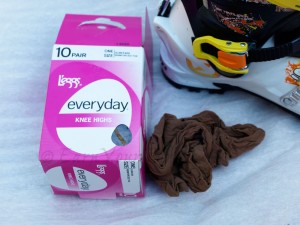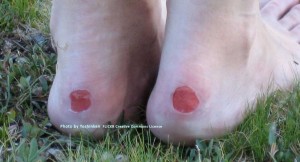One of the most common foot ailments of skiers and hikers are blisters. Half the problem stems from imperfectly fitting shoes or boots. The other half from the manner in which blisters form.
The common solution, one I’m adamantly opposed to, is to apply duct tape over the existing blister, or as prevention over a known zone of trouble. Duct tape has to be one of the stooopidest solutions to this problem I’ve ever encountered.
The cure is rather simple: eliminate or reduce the friction. Putting Duct Tape over a potential blister zone only increases the friction by increasing the contact with the epidermus via the glue on the tape. The slick outer surface of the tape has been known to occasionally help, but this is not a reliable condition. Even if duct tape does work by providing a slippery surface over your skin there are far better ways to achieve the same thing.
One method is to apply a patch of slippery material to the inside of the footwear causing the blister (not the foot). This is what Engo patches do. I haven’t used them myself, but have no doubt that they do what they say they do. However they only reduce the friction between your sock and footwear, not between your socks and skin! Thus, this is only half a solution and the least effective half at that.

Let ’em laugh. Use knee-high nylons and eliminate the sheer forces that cause blisters and get the last laugh on macho men who refuse to listen.
For severe, recurring blister problems you should consider a three pronged approach. First, get new shoes or boots, or have them adjusted so they conform more closely to your foots unique anatomical shape. Secondly, wear knee-high nylons under your socks. And if those two don’t completely eliminate the problem, add a pair of ENGO patches.
© 2013
Related Links
Freedom from Friction



4 comments
Skip to comment form
“Blue polypro sock liners” for hiking work well. They are a little thicker than the stockings (+/- depending on fit of boot, will last longer)
It is hard to beat the 2-layer sock system for people who have problems. I’ve never tried the nylon idea. However, it has a similar feature to what I’ve moved toward. The problem I’ve had with the old somewhat shapeless blue polypro sock liners is that in some footwear, they slip down and bunch or allow the outer sock to slip down and bunch. That creates friction points. My new system that has worked great in all boots (foam ski liners, hiking boots) for 2 years now is to use a super thin but very elasticized/form fitting knee-high sock as the inner sock. They have the secondary benefit of keeping your outer sock from slipping down. So neither sock ever bunches up. Yahoo!
This seems similar to the nylon idea. I’ll have to try that… The Bridgedale socks I use as inner socks are sold for people who want ultrathin socks in their ski boots – they are so thin you can see through them in places. But they work great as a liner sock. They also seem reasonably durable (although I’m sure they won’t last as long as the blue polypro sock liners that last forever, like it or not). And they’ll be more expensive than nylons!
Once a blister has formed Compeed Blister Block (aka Band-Aid advanced healing patches etc) works a treat. These are ovals of flexible sticky plastic that cushion the dermis; they last for days and are waterproof.
I have used a thin neoprene product called EZ Feet. You put them on like a sock, but the only cover your heel. Never had a blister while using them. It is the same principle as the nylon stocking-they go under your sock